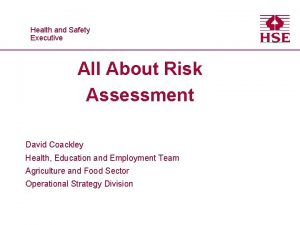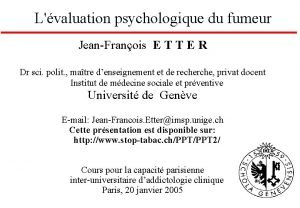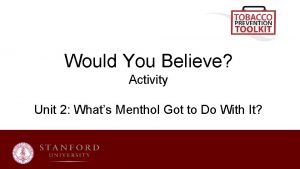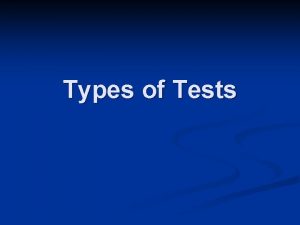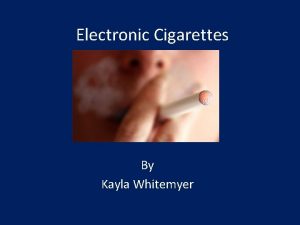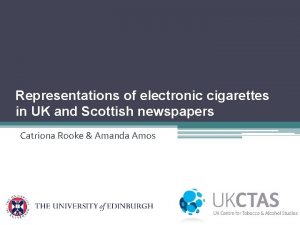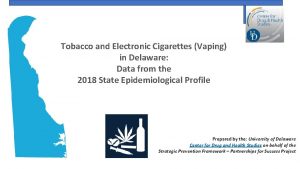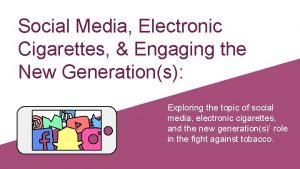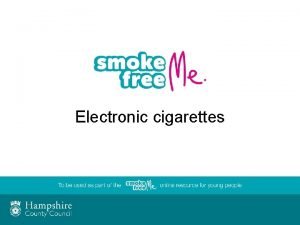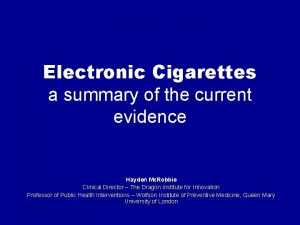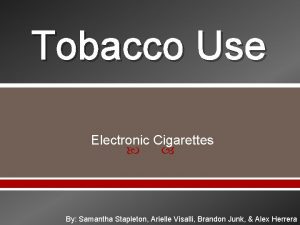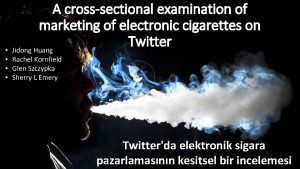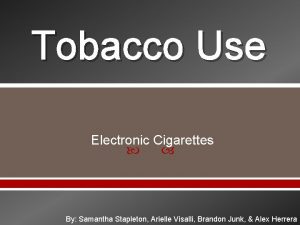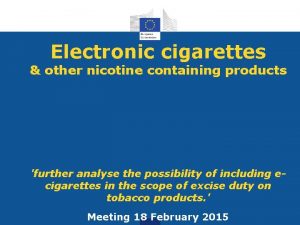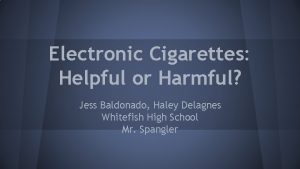Safety evaluation and risk assessment of electronic cigarettes



























- Slides: 27

Safety evaluation and risk assessment of electronic cigarettes as tobacco cigarette substitutes: a systematic review

Konstantinos E. Farsalinos and Riccardo Polosa Ibanez, Ma. Haidee

• Complete tobacco cessation is the best outcome for smokers – • Until recently, smokers were left with just two alternatives: – – • powerful addictive properties of nicotine and the ritualistic behavior of smoking either quit suffer the harmful consequences of continued smoking. But a third choice – involving the use of alternative and much safer sources of nicotine with the goal to reduce smoking-related diseases is now available: tobacco harm reduction (THR)

Electronic cigarettes (ECs) • the newest and most promising products for THR • Electrically-driven devices consisting of the – battery – an atomizer • liquid used mainly consists of propylene glycol, glycerol, distilled water, flavorings and nicotine. • Consumers may choose from several nicotine strengths, including non-nicotine liquids, and a countless list of flavors

• Invented in 2003, there has been constant innovation and development of more efficient and appealing products. • there are mainly three types of devices available

• Awareness and use (vaping) of ECs has increased exponentially in recent years – In the US from 2010 to 2011, EC use rising from 3. 3– 6. 2% – In the United Kingdom, EC use in regular smokers increased from 2. 7% in 2010 to 6. 7% in 2012. • A recent prospective study in Swiss army recruits showed that 12% of smokers who tried ECs progressed to daily use

• The popularity of ECs may be due to their ability to deal both with the physical (i. e. nicotine) and the behavioral component of smoking addiction. – sensory stimulation and simulation of smoking behavior and cigarette manipulation are important determinants of a product’s effectiveness in reducing or completely substituting smoking.

Risk differences compared with conventional cigarettes and the issue of nicotine • Conventional cigarettes are the most common form of nicotine intake. • Smoking-related diseases are pathophysiologically attributed to oxidative stress, activation of inflammatory pathways and the toxic effect of more than 4000 chemicals and carcinogens present in tobacco smoke. • In addition, each puff contains >1 × 1015 free radicals. • All of these chemicals are emitted mostly during the combustion process, which is absent in ECs. • Although the addictive potential of nicotine and related compounds is largely documented, much less dissemination has been given to the notion that nicotine does not contribute to smoking-related diseases. • It is not classified as a carcinogen by the International Agency for Research on Cancer [WHO-IARC, 2004]

• A major misconception, commonly supported even by physicians, is that nicotine promotes cardiovascular disease. • minimal effect in initiating and promoting atherosclerotic heart disease. • It does not promote platelet aggregation, does not affect coronary circulation and does not adversely alter the lipid profile. • It is anticipated that any product delivering nicotine without involving combustion, such as the EC, would confer a significantly lower risk compared with conventional cigarettes and to other nicotine containing combustible products.

• the addictive potential is an important factor in any decision to endorse nicotine administration; however, it should be considered as slight ‘collateral damage’ with minimal impact to vapers’ health compared with the tremendous benefit of eliminating all disease-related substances coming from tobacco smoking. • In fact, smokers are already addicted to nicotine; therefore the use of a ‘cleaner’ form of nicotine delivery would not represent any additional risk of addiction.

• Surveys have shown that ECs are used as long-term substitutes to smoking. • Although consumers try to reduce nicotine use with ECs, many are unable to completely stop its intake, indicating an important role for nicotine in the ECs’ effectiveness as a smoking substitute. • Nicotine overdose or intoxication is unlikely to occur with vaping, since the amount consumed and absorbed is quite low. • ECs have a huge theoretical advantage in terms of health risks compared with conventional cigarettes due to the absence of toxic chemicals that are generated in vast quantities by combustion.

Studies on the safety/risk profile of ECs

Chemical studies





• In conclusion, chemical studies have found that exposure to toxic chemicals from ECs is far lower compared with tobacco cigarettes. • Besides comparing the levels of specific chemicals released from tobacco and ECs, it should be taken into consideration that the vast majority of the >4000 chemicals present in tobacco smoke are completely absent from ECs. • Obviously, surveillance of use is warranted in order to objectively evaluate the in vivo effects and because the effects of inhaling flavoring substances approved for food use are largely unknown.

Toxicological studies • • In conclusion, toxicological studies have shown significantly lower adverse effects of EC vapor compared with cigarette smoke. Characteristically, the studies performed by using the liquids in their original liquid form have found less favorable results; however, no comparison with tobacco smoke was performed in any of these studies, and they cannot be considered relevant to EC use since the samples were not tested in the form consumed by vapers. More research is needed, including studies on different cell lines such as lung epithelial cells. In addition, it is probably necessary to evaluate a huge number of liquids with different flavors since a minority of them, in an unpredictable manner, appear to raise some concerns when tested in the aerosol form produced by using an EC device.

Clinical studies • In conclusion, clinical studies evaluating the effects of short-term EC use on selected cardiovascular and respiratory functional outcomes have shown that even if some harmful effects of vaping are reported, these are considerably milder compared with smoking conventional cigarettes. • However, it is difficult to assess the prognostic implications of these studies; longer-term data are needed before any definite conclusions are made.

Passive vaping • Passive smoking is an established risk factor for a variety of diseases. • the potential of any significant adverse effects of EC on bystanders is minimal. • aerosol is produced only during activation of the device, while tobacco cigarettes emit smoke even when no puffs are taken. • emissions from an EC only formaldehyde, acrolein, isoprene, acetaldehyde and acetic acid were detected. – The levels were 5– 40 times lower compared with emissions from a conventional cigarette. • Characteristically, the amount of TOC accumulated after 5 hours of EC use was similar to the amount found after just 11 minutes of smoking.

• Therefore, the risk for bystanders would be literally nonexistent. • They observed that the half life of EC aerosol was 11 seconds compared with 20 minutes for cigarette smoke. • ECs may emit detectable amounts of nicotine (depending on the specific EC brand tested), but no carbon monoxide and volatile organic carbons. However, the average ambient levels of nicotine of ECs were 10 times lower than those of conventional cigarettes (3. 32 � } 2. 49 versus 31. 60 � } 6. 91 μg/m 3). • Researchers found significant adverse effects in spirometry parameters after being exposed to passive smoking for 1 hour, while no adverse effects were observed after exposure to passive vaping.

Miscellaneous safety issues • Specific subpopulations: psychiatric patients – This subpopulation is characterized by a very high smoking prevalence with an excess of smoking-related mortality – Currently, only NRTs are recommended to treat nicotine dependence in this specific subpopulation, but in general they are not particularly effective. – ECs could be used as an alternative to smoking products in this group. – A study was done which showed no deterioration in their psychiatric condition, and side effects were mild and temporary. – There is also anecdotal evidence that successful smoking cessation could be attained by using an EC in smokers with other psychiatric conditions such as depression.

Miscellaneous safety issues • Specific subpopulations: chronic obstructive pulmonary disorder Patients – Consequently, smoking cessation plays a crucial part in the management of COPD patients. – However, the available evidence in the medical literature indicates that COPD patients who smoke respond poorly to smoking cessation efforts To date, no formal efficacy and safety assessment of EC use in COPD patients has been conducted. – There is only evidence from a case report of inveterate smokers with COPD and a documented history of recurring relapses, who eventually quit tobacco smoking on their own by using an EC – Significant improvement in quality of life and reduction in the number of disease exacerbations were noted.

• Accidental nicotine exposure – acute dose associated with a lethal outcome would be 500– 1000 mg. – There is no evidence that nicotine-containing EC liquids should be treated in any different way compared with other consumer products used every day in households (such as bleach, washing machine powder, etc. ) • Electrical accidents and fires – The electronic equipment of ECs may be the cause for accidents. – ECs are mainly composed of lithium batteries. – There have been reports of explosions of batteries, caused either by prolonged charging and use of improper chargers or by design defects, similar with mobile phones. – Therefore, this does not occur specifically with ECs, however, quality standards of production should be used in order to avoid such accidents.

Conclusion • Existing evidence indicates that EC use is by far a less harmful alternative to smoking. • There is no tobacco and no combustion involved in EC use; therefore, regular vapers may avoid several harmful toxic chemicals that are typically present in the smoke of tobacco cigarettes. • Indeed, some toxic chemicals are released in the EC vapor as well, but their levels are substantially lower compared with tobacco smoke. • Moreover, ECs are recommended to smokers or former smokers only, as a substitute for conventional cigarettes or to prevent smoking relapse; thus, any risk should be estimated relative to the risk of continuing or relapsing back to smoking and the low efficacy of currently approved medications for smoking cessation should be taken into consideration.

• Nonetheless, more research is needed in several areas, such as atomizer design and materials to further reduce toxic emissions and improve nicotine delivery, and liquid ingredients to determine the relative risk of the variety of compounds (mostly flavorings) inhaled. • Regulations need to be implemented in order to maintain the current situation of minimal penetration of EC use in nonsmokers and youngsters, while manufacturers should be forced to provide proof for the quality of the ingredients used and to perform tests on the efficiency and safety of their products.
 Health and safety risk assessment template
Health and safety risk assessment template Market risk credit risk operational risk
Market risk credit risk operational risk Electronic field production examples
Electronic field production examples Safety assessment for ind safety reporting
Safety assessment for ind safety reporting Scrip exchange
Scrip exchange Jin ling cigarettes
Jin ling cigarettes Camel cigarettes subliminal advertising
Camel cigarettes subliminal advertising An anthology of eleven short stories cigarettes
An anthology of eleven short stories cigarettes Young and dyslexic analysis essay
Young and dyslexic analysis essay 365 ats cigarettes
365 ats cigarettes Brian cigarettes
Brian cigarettes Why is adding menthol to cigarettes dangerous?
Why is adding menthol to cigarettes dangerous? Family mart marketing mix
Family mart marketing mix Withdrawal symptoms from cigarettes
Withdrawal symptoms from cigarettes Concept map of measurement assessment and evaluation
Concept map of measurement assessment and evaluation Kcapanse
Kcapanse Community health planning and implementation
Community health planning and implementation Chapter 11 assessment and evaluation of sports injuries
Chapter 11 assessment and evaluation of sports injuries Continuity assessment record and evaluation
Continuity assessment record and evaluation Concept of measurement assessment and evaluation
Concept of measurement assessment and evaluation Difference between assessment and evaluation
Difference between assessment and evaluation Fatality assessment and control evaluation
Fatality assessment and control evaluation Residual risk and secondary risk pmp
Residual risk and secondary risk pmp Business risk and financial risk leverage
Business risk and financial risk leverage Relative risk calculation
Relative risk calculation Relative risk
Relative risk E-sat survey
E-sat survey D&b supplier evaluation risk rating
D&b supplier evaluation risk rating
